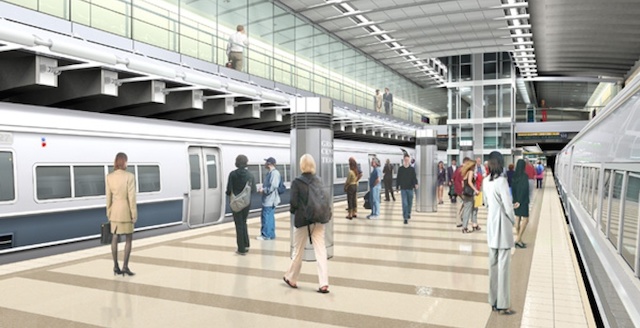Today, more than a decade late and after spending $11.2 billion, the Long Island Railroad will begin running trains to Grand Central Terminal. This 3.5-mile project, known as the East Side Access tunnel, cost a mere $3.2 billion a mile, which is a trifle compared with the Second Avenue Subway, the next segment of which is expected to cost $4 billion a mile.
Architect’s vision of what new LIRR platform will look like in Grand Central Terminal. Source: STV Inc.
Meanwhile, New York transit has a $26.6 billion capital funding gap over the next two years. One result of this is that more than a quarter of the region’s transit vehicles are beyond the end of their expected service life.
Up in Boston, the Massachusetts Bay Transportation Authority (MBTA) has been forced to place speed restrictions on its track in 70 different locations. The track is in such poor condition that trains are sometimes required to slow to walking speeds. Not to worry: the MBTA was able to complete its 4.7-mile, $2.3 billion Green Line extension last December. At almost $500 million a mile, it’s the most expensive above-ground light-rail line ever built. But it demonstrated to the world that the MBTA, like the MTA, cares more about new construction than the safety of its customers.
People have been fretting over why transit infrastructure is so expensive in the United States. What they should be asking is why transit agencies insist on building more infrastructure when they can’t afford to keep the infrastructure they already have in a state of good repair.









Just guessing here … but … if busses were to operate the routes on which many people currently drive to work, wouldn’t they reduce the number of cars on these routes and therefore require little or no additional infrastructure?
But we know the answer because … the routes that people use to drive to work were once served by busses and streetcars.
Oh well …
Actually, I would say many if not most routes that people drive nowadays were never served by buses or streetcars. In New York, some routes within the city (I would say four of the five boroughs) are that way, but not the majority of trips in the metro region. And many would be difficult if not impossible to serve even with buses. In New Jersey, want to try Plainfield to Englewood Cliffs by transit? West Orange to Upper Saddle River? Those are some of the commutes I did.